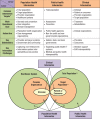A proposed national research and development agenda for population health informatics: summary recommendations from a national expert workshop
- PMID: 27018264
- PMCID: PMC5201177
- DOI: 10.1093/jamia/ocv210
A proposed national research and development agenda for population health informatics: summary recommendations from a national expert workshop
Abstract
Objective: The Johns Hopkins Center for Population Health IT hosted a 1-day symposium sponsored by the National Library of Medicine to help develop a national research and development (R&D) agenda for the emerging field of population health informatics (PopHI).
Material and methods: The symposium provided a venue for national experts to brainstorm, identify, discuss, and prioritize the top challenges and opportunities in the PopHI field, as well as R&D areas to address these.
Results: This manuscript summarizes the findings of the PopHI symposium. The symposium participants' recommendations have been categorized into 13 overarching themes, including policy alignment, data governance, sustainability and incentives, and standards/interoperability.
Discussion: The proposed consensus-based national agenda for PopHI consisted of 18 priority recommendations grouped into 4 broad goals: (1) Developing a standardized collaborative framework and infrastructure, (2) Advancing technical tools and methods, (3) Developing a scientific evidence and knowledge base, and (4) Developing an appropriate framework for policy, privacy, and sustainability. There was a substantial amount of agreement between all the participants on the challenges and opportunities for PopHI as well as on the actions that needed to be taken to address these.
Conclusion: PopHI is a rapidly growing field that has emerged to address the population dimension of the Triple Aim. The proposed PopHI R&D agenda is comprehensive and timely, but should be considered only a starting-point, given that ongoing developments in health policy, population health management, and informatics are very dynamic, suggesting that the agenda will require constant monitoring and updating.
Keywords: informatics agenda; population health informatics; public health informatics.
© The Author 2016. Published by Oxford University Press on behalf of the American Medical Informatics Association. All rights reserved. For Permissions, please email: journals.permissions@oup.com.
Figures


References
-
- Charles D, Gabriel M, Furukawa M. Adoption of Electronic Health Record Systems among U.S. Non-federal Acute Care Hospitals: 2008-2013. Office of National Coordinator for Health Information Technology; 2014 https://www.healthit.gov/sites/default/files/oncdatabrief16.pdf. Accessed March 4, 2013.
-
- Charles D, King J, Furukawa MF, Patel V. Hospital adoption of electronic health record technology to meet meaningful use objectives: 2008-2012. Office of the National Coordinator for Health Information Technology. 2013. http://www.healthit.gov/sites/default/files/oncdatabrief10final.pdf. Accessed March 2, 2013.
-
- Jha A, Burke M, DesRoches C, et al. Progress toward meaningful use: hospitals’ adoption of electronic health records. Am J Managed Care. 2011;17 (12 Spec No.):SP117-SP124. - PubMed
-
- Hsiao CJ, Hing E, Ashman J. Trends in Electronic Health Record system use among office-based physicians: United States, 2007-2012. National Center for Health Statistics. 2014. http://www.cdc.gov/nchs/data/nhsr/nhsr075.pdf. Accessed September 20, 2014.
Publication types
MeSH terms
Grants and funding
LinkOut - more resources
Full Text Sources
Other Literature Sources

